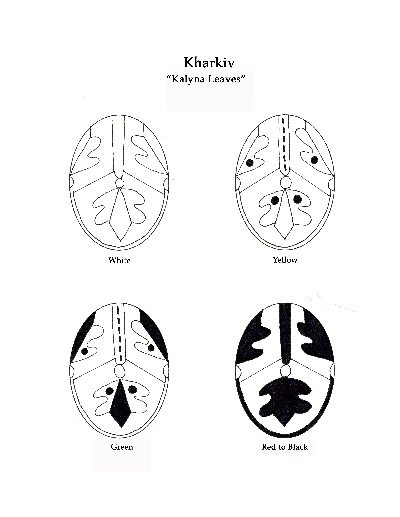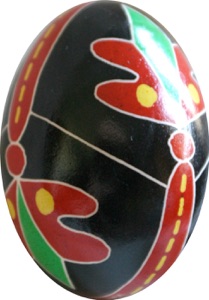Kharkiv
Харківщина
Kharkiv
Харківщина

Phytomorphic (plant-like) elements are often found on pysanky from Ukraine’s north and east. Pysanky from the Kharkiv region are usually fairly simple (non-complex), and often display flowers, leaves and vazony. The color scheme is yellow, red and black, with or without green. Most of the pysanky have a dark background color, with the exception of the occasional red/green pysanka.
Onyshchuk appears to have taken this pysanka from Kulzhynskyi; below are her version (left) and his (Plate XXXI-14, № 187). She appears to have changed to colors and added some dots. She may have had a different source, but the similarities are too close for chance.


With the exception of oak leaves, most phytomorphic elements on pysanky do not bear much of a resemblance to their namesakes. The leaves above are vaguely shaped like kalyna leaves, but the colors and marking are all wrong. It is possible that many of these symbols had other meanings when they were created, and the names changed over the years. Similar “leaves” are seen on many other pysanky from this area, on pysanky without names. Sadly, due to Soviet repression of pysankarstvo in eastern Ukraine, these names will probably never be known.
Flowers and leaves can be difficult to differentiate on pysanky; they often look quite alike. Often the flowers on traditional pysanky are called “tulips” and “orchids,” neither of which grew traditionally in Ukraine. In these cases, the pysankary were giving exotic names to the fantastical flowers they were writing.

Technical details: This is an example of a pysanka that is fairly easy to write, but a bit difficult to plot. It is based on the “Sakvy” division, which can be hard for beginners and even some more skilled pysankary to plot. I would place the difficulty as moderate overall.
As with most traditional designs, a medium stylus is best for the lines, and a wide for waxing in. You could use a fine for outlining, as I did above, but the line width should really be heavier in simpler designs like this.
This pattern utilizes yellow, green, red and black dyes. The green can be applied either by spot dyeing, or you can dye the entire egg green and then remove it with an orange rinse prior to coloring it red.
As I noted previously, the line width in the example above is wrong. A traditional pysanka such as this, with a simple design, should have heavier (medium) lines.
Download this pattern sheet:
Back to MAIN Patterns page.
Back to MAIN Regional Pysanky page.
Back to MAIN Traditional Pysanky page.
Search my site with Google
Kalyna Leaves
Калиновий Лист
